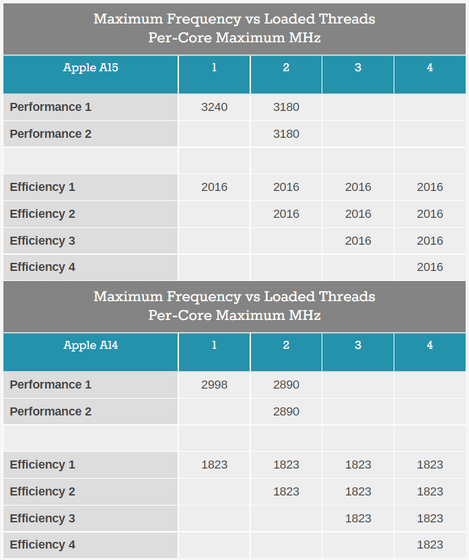Benchmark test results showing the performance of the SoC 'A15 Bionic' installed in the iPhone 13 series will be announced

Introduced on September 24, 2021, the iPhone 13 series is powered by Apple's SoC, the A15 Bionic chip. AnandTech, a hardware news site, has released the results of its A15 performance review.
The Apple A15 SoC Performance Review: Faster & More Efficient
The A15 has two high-performance CPU cores and four high-efficiency CPU cores, a GPU with four cores on the iPhone 13/13 mini, five cores on the iPhone 13 Pro / 13 Pro Max, and a high-speed neural engine with 16 cores. increase. Apple said CPU performance was '50% faster than its competitors,' and GPUs were '30% faster than its competitors' A15 and 5-core GPU's A15 50% faster. I was appealing with an ambiguous expression.
◆ CPU core operating frequency
According to AnandTech, the A15 has an 8% improvement in the peak frequency of the single core, which is a high-performance core, compared to the previous generation A14. It was 2998MHz on the A14, but reached 3240MHz on the A15. In addition, the peak frequency when two high-performance cores are operating was 2890MHz on the A14, but it was 3180MHz on the A15, an increase of 10%. In addition, the high efficiency core of A15 can now be clocked up to 2016MHz, which is 10.5% higher than that of A14.

It is said that the A14 uses TSMC's '
◆ Cache memory
Apple has revealed that 'A15 has doubled the cache memory compared to A14', and the SLC cache of A14 was 16MB like A13, but doubled to 32MB in A15. In addition, AnandTech pointed out that the L2 cache of the high-performance core was also increased from 8MB on the A14 to 12MB on the A15, which is the same as the Apple M1. In addition, by increasing the L2 TLB of the high efficiency core to 2048 entries, the latency of DRAM access is lower than that of A14.
◆ CPU core power efficiency
Below is a bubble chart that summarizes the score (vertical axis) and energy consumption (joule, horizontal axis) of SPECint 2017 , which performs integer arithmetic and floating point arithmetic. The high-performance core (A15 P) consumes slightly less energy and improves the score than the A14. The high efficiency core (A15 E) consumes the same amount of energy and has an improved score, indicating that the overall energy efficiency has increased.

◆ GPU benchmark
The iPhone 13/13 mini has a 4-core GPU, similar to the A14-equipped iPhone 12 series. However, the iPhone 13 Pro / 13 Pro Max uses the A15 with five GPU cores.
The result of the benchmark test using


The test result (Aztec Ruins / High Tier) by GFXBench looks like this. The iPhone 13 Pro has a 46% higher score than the 12 Pro. The iPhone 13 has recorded a 19% score improvement.

Below is a summary of the above table in a bubble chart with performance (fps) on the vertical axis and power (W) on the horizontal axis. AnandTech runs the GFX Bench in three modes to measure the score, and in all the results, 'The peak performance of the A15 has improved significantly, but the power consumption has improved slightly compared to the A14. The efficiency has improved significantly because it has been done. '

AnandTech says that SoC benchmarks are not always directly linked to the user experience, and 'I'm reluctant to publish actual gameplay as a result of SoC benchmark tests.'
For example, below is playing


And the following image is playing 'Genshin' on iPhone 13 Pro Max equipped with A15. AnandTech said, 'The comparison between Android and iPhone is more complicated, the iPhone has a slightly higher resolution even with the same game settings, and there are visual effects that the Android version does not have,' said the experience of actually playing the game. Argues that it is not directly linked to the benchmark results.

AnandTech said, 'What we've shown in this study is just the tip of the performance iceberg of the iPhone 13 series, but a glimpse into what the new A15 is achieving and what it can be expected to do in terms of performance. You can do it. ' The A15's CPU is shifting towards power efficiency over pure performance, the A15's GPU has both improved performance and efficiency, and the A15 is a spectacularly high-performance SoC. Although not, AnandTech evaluates that it has evolved into a much better SoC than the A14.
Related Posts:







